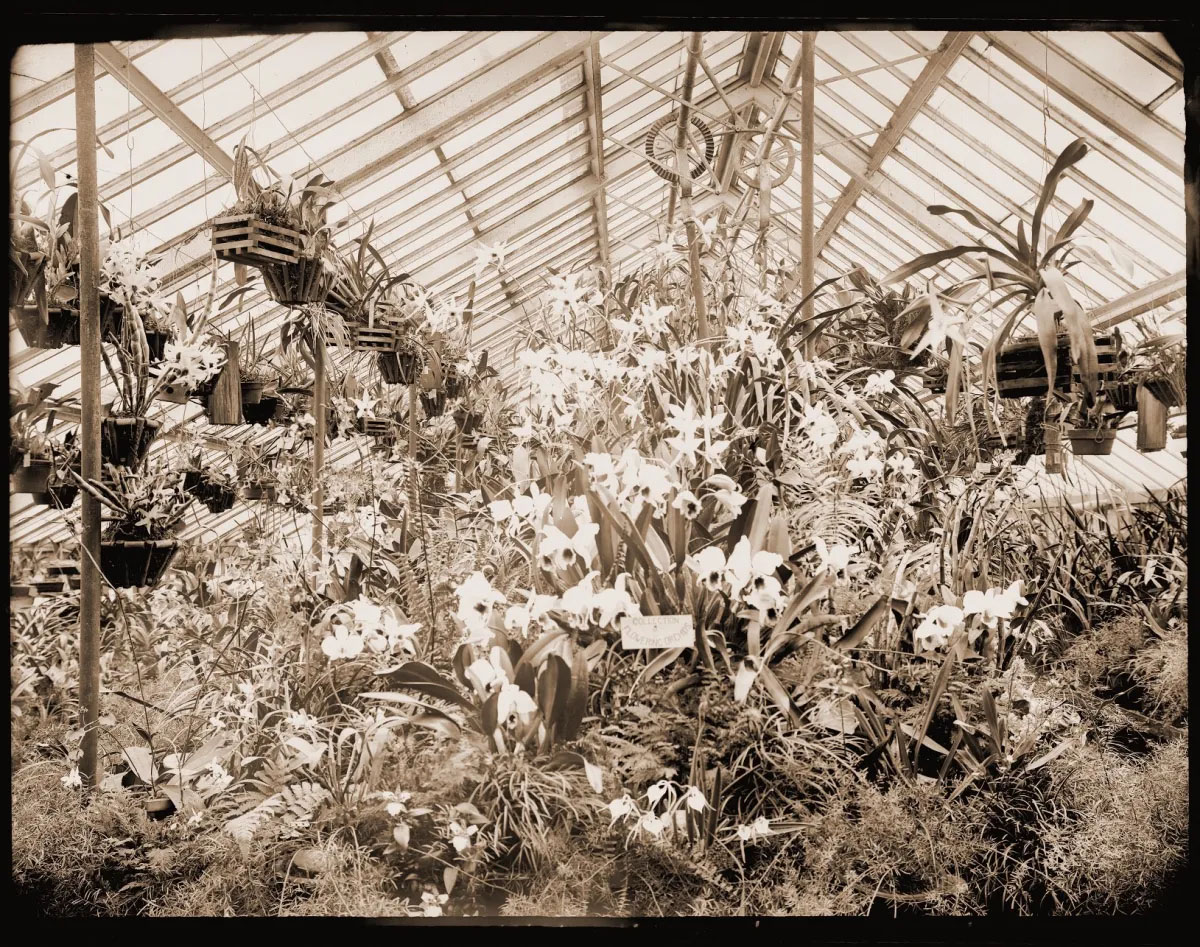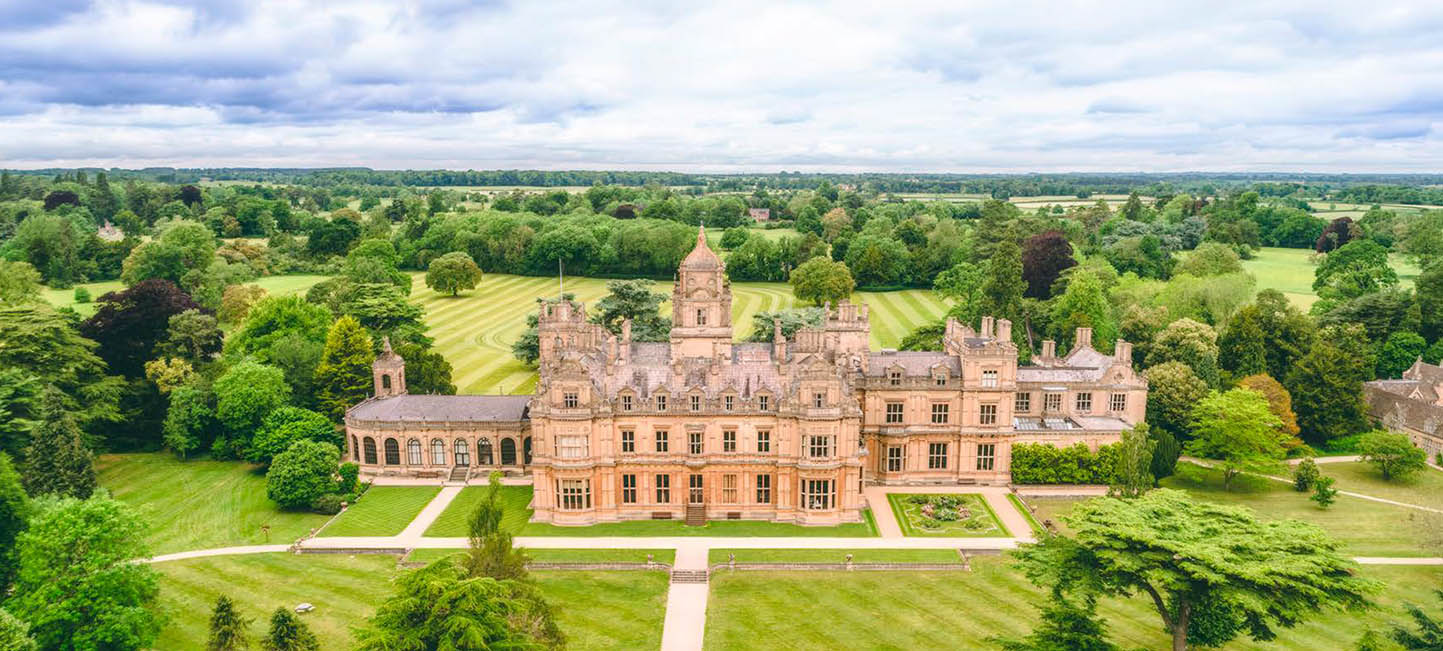0
You have 0 items in your cart
‘Orchids are so extremely popular to-day that they to some extent represent the horticultural respectability of many nineteenth century gardens.’
Sir Trevor Lawrence, 1885

Above: Victorian-era orchid grenhouse
In Victorian Britain, orchids reigned supreme as the ultimate status symbol. The wealthy engaged in conspicuous consumption—spending lavishly to display their social position—and no flower better served this purpose than these exotic blooms. Essential for prestigious weddings and social gatherings, orchids adorned George Holford’s own marriage to Susannah Menzies at Westonbirt in 1912. These flowers weren’t merely grown; they were exhibited as visible proof of one’s refinement and resources.
While an 1897 account described orchids as “not grown so extensively” at Westonbirt compared to other estates, this understates the reality. Contemporary articles reveal multiple “large proportioned” greenhouses dedicated solely to different orchid varieties—a Cattleya house, a Dendrobium house, an Odontoglossum house, and an “East Indian house.” The Victorian standard for an “extensive” collection clearly exceeded today’s definition. The competitive pursuit of rare species remained fierce among elite growers, with Holford himself promptly acquiring the newly discovered Coelogyne mooreana in 1907, just one year after its importation by Sander. When his specimen flowered in 1908, Holford proudly submitted an image to The Orchid Review, announcing his horticultural triumph to society.
The Holford Legacy
The Westonbirt orchid collection reached its zenith under Sir George Holford, who inherited both his father Robert Holford’s estate and his passion for orchids. By the early 20th century, Westonbirt’s orchid houses had expanded to cover nearly an acre of glass, requiring a dedicated staff of fifteen gardeners solely for orchid cultivation. The estate employed H.G. Alexander as its head orchid grower, a man whose expertise would eventually earn him the Victorian Medal of Horticulture—the highest honour in British gardening.
Alexander’s meticulous cultivation methods produced specimens of unprecedented quality. Westonbirt orchids dominated the Royal Horticultural Society shows, with contemporary accounts describing their displays as “sensational” and “magnificent beyond description.” At the 1904 RHS Temple Show, Holford’s Odontoglossum crispum varieties caused such a sensation that King Edward VII personally congratulated him on their beauty.

Above: The wedding of Sir George Holford, Westonbirt’s owner, to Sussanah Menzies. She is holding a bouquet of orchid flowers
Industrial-Scale Luxury
The scale of orchid cultivation at Westonbirt represented a remarkable intersection of industrial methodology and aristocratic luxury. The estate maintained detailed breeding records, temperature logs, and feeding schedules that mirrored the scientific precision of other Victorian industrial enterprises. Holford installed the most advanced heating systems available, with miles of hot water pipes ensuring each house maintained the precise temperature and humidity required for different orchid genera.
Annual coal consumption for heating the orchid houses alone reportedly exceeded 300 tons—an environmental cost that went unquestioned in Victorian Britain but represents an astonishing carbon footprint by modern standards. This extravagant resource allocation for purely ornamental purposes exemplified the Victorian upper class’s approach to nature as something to be conquered, controlled, and displayed.
Breeding Innovations
Beyond merely collecting, Westonbirt became known for groundbreaking hybridization work. Alexander and Holford created numerous hybrids that remain in cultivation today, including the celebrated Cymbidium ‘Westonbirt’ varieties. These breeding programs required patience measured in decades—some orchid seedlings took seven years or more to reach flowering size.
The estate developed specialized propagation techniques, maintaining a “stud collection” of particularly valuable breeding plants. These weren’t merely aesthetic pursuits but represented significant financial investments. At auction in 1914, a single specimen of Cattleya ‘Westonbirt variety’ sold for 500 guineas (equivalent to over £60,000 today).
Preservation Through Transfer
What makes the Westonbirt collection particularly notable is its unusual fate. When Sir George Holford died in 1926, he made an unprecedented decision for the time: rather than allowing his collection to be sold off piecemeal, he bequeathed the entire orchid collection to Alexander himself—recognizing that the plants’ value lay as much in the knowledge of how to grow them as in the specimens themselves.
Alexander continued cultivating the collection commercially until the 1950s, when changing economic conditions and heating costs made maintaining such extensive glasshouses impractical. Worried about his health and with both sons having died in World War II, he retired and sold up. During World War II, many important specimens were sent to the United States for safekeeping, where they are still cultivated today – living botanical artifacts of a vanished era of aristocratic plant obsession.

Above: Westonbirt House, home of the Holford family until 1926. The orchid collection and nursery was adjacent to the house
The Arboretum Connection
While Westonbirt is now world-famous for its arboretum rather than its orchids, both collections stemmed from the same Victorian passion for botanical collecting and classification. The same impulse that drove the Holford family to import rare trees from around the world motivated his orchid acquisitions. This collecting ethos—simultaneously scientific, aesthetic, and status-driven—defined the Victorian relationship with exotic plants.
Today, visitors to Westonbirt Arboretum walk amongst the living legacy of tree collection while the orchid houses exist only in photographs and written accounts. Yet both represent important chapters in Britain’s horticultural history and the complex relationship between imperial power, scientific exploration, and the Victorian conquest of nature.
[1] “Westonbirt” in Journal of Hortculture and Cottage Gardener, 16 September 1897, Westonbirt Archive A120
[2] “Weston Birt” in The Gardener’s Chronicle, 9 July 1881, Westonbirt Archives A111, p. 43
[3] Coelogyne mooreana in The Orchid Review, November 1908